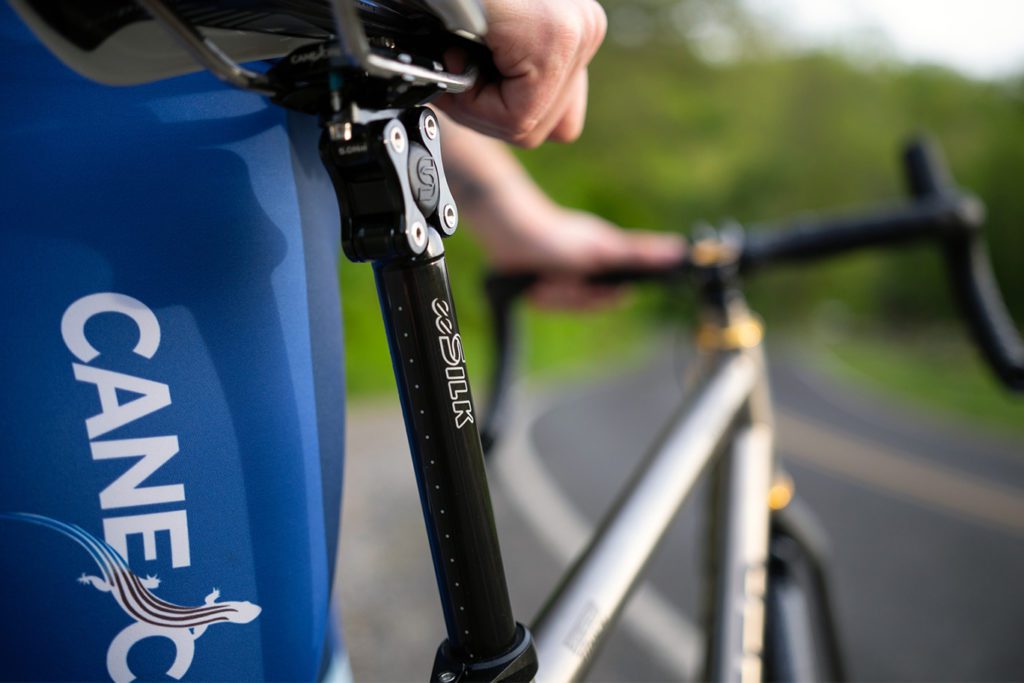

We were excited about the eeSilk seat post when we introduced it. We believed it provided a compliance benefit that rivaled more complicated bicycle frame designs. This meant someone could expand their riding to rougher backroads and gravel roads without having to drop thousands on a new bike. Plus, at under 300g the eeSilk added little weight compared to many stock posts.
With the booming popularity of gravel riding (especially in the U.S.), we expected the eeSilk would be a sales success as well. While some were pushing the boundaries of drop bar riding into what had been the domain of mountain bikes, most gravel riders were looking to connect paved roads and/or get away from traffic — not descending root-strewn singletrack. Thus, a compliance post offered rider benefit anytime the surface was bumpy, wherein a dropper post only offered benefit in limited situations.
But we got hit with a double whammy. First, our industry has been stuck on selling the extreme elements of cycling. To make a tool like a competent gravel bike sexy, marketing departments and media promoted extreme riding espousing dropper posts as opposed to stress free miles of gravel road bliss on a compliant post.
The second whammy was our own doing. Some riders were bothered by play and creaking in the eeSilk pivots. For optimum compliance, the posts must be very active which requires low friction in the pivots. We erred on the side of larger tolerances in order to achieve said activeness, but some riders did not like the play some posts had due to tolerance stack-up. Harder to ignore was that the bushing spec was prone to creaking in certain conditions.
Disappointed for being so close but missing the bullseye, we set out on a redesign. At a glance the new “2.0” post looked basically the same but had significant changes to the pivot design and materials. We were adamant that no annoying pivot play would be present. The other proven design elements did not change. Various prototypes performed well on the bike and in the test lab. And so we moved on towards production.
When the first pre-production posts were installed on bikes, they didn’t function… I mean that they hardly moved at all unless you stayed seated on a big enough impact for which you should have been standing. What happened? We found that in our quest to fight pivot play, we stacked the tolerances too tightly for production. Fortunately, we were able to dial in the tolerances with rapid iterative ride testing. We modified the production parts, built new pre-production posts, and were happy. Until…
We had sold the last of the original eeSilk posts months before, but orders kept coming in. We had planned to fill those orders with the announcement of an updated post, but the issues explained above prevented this. Once those issues were addressed, we began gearing up for production and a public reveal, until we discovered that the torque for the removable pivot was way too high. The high torque spec was carried over from the original post but was not right for the new design. That was a quick fix once we figured it out, and then we were finally ready for production. Until…
While the tweaks to address the above issues were not re-designs, they were enough for us to repeat ISO testing to ensure that the overall package still exceeded industry standards. And to our astonishment, we saw issues with parts that did not have issues on the original design, the prototypes, or the preproduction samples. That’s when we hit the Pause button (it’s like the X button on America’s Got Talent, but louder). We had been pushing hard and fast because we knew the eeSilk should add real rider benefit, the gravel market was hot, and we had a backlog of demand. But it was clear that we need to take a breath and back off.
Not pushing through with orders in hand and parts on the shelf was not easy, and fortunately, Cane Creek was financially stable enough to make such a choice. We decided that some time and space would be conducive to a better perspective on the problem. We have recently been slowly increasing our attention on the eeSilk post, and as I write this, things look promising. I am confident we will re-introduce the post, and it will perform as intended. Despite the frustrations, I am proud of the work our team has done, and that we had the courage and ability to hit the Pause button.
Monday: 10:00 am – 5:00 pm
Tuesday – Thursday: 10:00 am – 5:00 pm
Friday: 10:00 am – 5:00 pm
Saturday – Sunday: Closed